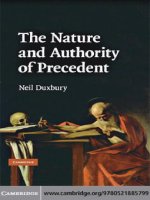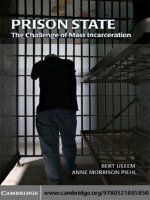cambridge university press the apology ritual a philosophical theory of punishment sep 2008 kho tài liệu bách khoa
Bạn đang xem bản rút gọn của tài liệu. Xem và tải ngay bản đầy đủ của tài liệu tại đây (1.06 MB, 222 trang )
This page intentionally left blank
THE APOLOGY RITUAL
Christopher Bennett presents a theory of punishment grounded in
the practice of apology, and in particular in reactions such as feeling
sorry and making amends. He argues that offenders have a `right to be
punished' – that it is part of taking an offender seriously as a member
of a normatively demanding relationship (such as friendship or
collegiality or citizenship) that she is subject to retributive attitudes
when she violates the demands of that relationship. However, while he
claims that punishment and the retributive attitudes are the necessary
expression of moral condemnation, Bennett's account of these reactions has more in common with restorative justice than traditional
retributivism. He argues that the most appropriate way to react to
crime is to require the offender to make proportionate amends. His
book is a rich and original contribution to the debate over punishment
and restorative justice.
is a Lecturer in the Department of
Philosophy, University of Sheffield.
CHRISTOPHER BENNETT
THE APOLOGY RITUAL
A Philosophical Theory of Punishment
CHRISTOPHER BENNETT
CAMBRIDGE UNIVERSITY PRESS
Cambridge, New York, Melbourne, Madrid, Cape Town, Singapore, São Paulo
Cambridge University Press
The Edinburgh Building, Cambridge CB2 8RU, UK
Published in the United States of America by Cambridge University Press, New York
www.cambridge.org
Information on this title: www.cambridge.org/9780521880725
© Christopher Bennett 2008
This publication is in copyright. Subject to statutory exception and to the provision of
relevant collective licensing agreements, no reproduction of any part may take place
without the written permission of Cambridge University Press.
First published in print format 2008
ISBN-13 978-0-511-42340-6
eBook (EBL)
ISBN-13
hardback
978-0-521-88072-5
Cambridge University Press has no responsibility for the persistence or accuracy of urls
for external or third-party internet websites referred to in this publication, and does not
guarantee that any content on such websites is, or will remain, accurate or appropriate.
For Sue
Contents
Acknowledgements
page viii
Introduction
PART I
1
JUSTIFYING PUNISHMENT
11
1
The problem of punishment and the restorative alternative
13
2
Some retributivist themes
26
PART II
RESPONDING TO WRONGDOING
45
3
Responsibility, reactive attitudes and the right to be punished
47
4
Non-retributive dialogue
74
5
The cycle of blame and apology
101
PART III
THE APOLOGY RITUAL
123
6
Restorative justice and state condemnation of crime
125
7
Institutional blame and apology
152
8
The Apology Ritual and its rivals
175
Bibliography
Index
199
208
vii
Acknowledgements
The first draft of the present manuscript was completed with the help of
an AHRB Research Leave Scheme grant during 2005–6. But the ideas
expressed here are ones that I have been working on for what now seems
like rather a long time. Because it has taken so long to write I am afraid
I cannot hope to acknowledge or thank everyone who has helped me in
some way to develop the ideas presented here. This does not mean that
I am not grateful to those who have taken the time to ask difficult or
encouraging questions, or with whom I have had enlightening discussions.
But there are some people I would like to mark out for thanks, starting
with Tom Pink, Bob Stern, Leif Wenar and David Owens, who provided
immeasurable help in the early stages of this project. I would also like to
give particular thanks to Antony Duff for his generous support, advice and
encouragement over the years.
I would also like to thank those who volunteered to look at drafts
of the book, either as a whole or as sets of chapters: Linda Radzik,
Leo Zaibert, Kimberley Brownlee, and John Tasioulas. I am also grateful
to Richard Holton, John Skorupski, Gerry Johnstone, Matt Matravers,
Andrew Schaap, Suzanne Uniacke, Rowan Cruft, Jim Dignan, Mick
Cavadino, Julie Brownlie, Simon Anderson, Thom Brooks, Daniel Van
Ness, Gwen Robinson, Joanna Shapland, Pedro Tabensky and Richard
Dagger, audiences at Durham and Glasgow Philosophy Departments and
Birkbeck College Law Department. Thanks also to an anonymous referee
for Cambridge University Press who provided helpful and incisive comments. I am also grateful to my colleagues in Sheffield, who have continued to provide a supportive and stimulating research environment, as
well as an object lesson in philosophical argument.
In addition I would like to record a special debt of gratitude to Sandra
Marshall, with whom I had many formative philosophical discussions:
I hope she recognises her influence in these pages.
viii
Acknowledgements
ix
Closer to home I would like to thank my parents and my brothers for
support, encouragement and stimulation of many kinds. And finally of
course the biggest `thank you' goes to Sue, Sarah and Lois for putting
up with having a philosopher in the house.
Introduction
an everyday story
After a hard day at the office Bryson gives in to the cajoling of a couple of
his colleagues and decides to join them for a drink. Stretching out his legs
in the pub he savours the atmosphere, the chat and the sheer leisure of
having nothing to do until the next morning, while the alcohol courses
into his blood and makes the world appear that little bit rosier. The only
problem is, he drives to work, and will need to drive home again. This
fact hovers constantly more or less into focus in his mind, and he makes
it clear to his mates that he will not be staying with them for long.
Nevertheless, as he is about to get up to leave, having had as much to
drink as he ought to in the situation, they persuade him to stay for one
more. It is not that Bryson is naturally reckless or that he does not care
about the danger he might be to others when he is under the influence:
this fact has been more or less present to his mind all along. It is just that,
after he has had a couple of drinks, this aspect of the situation slips out of
his awareness under pressure from his friends. In the delicious relaxation
of the moment he assures himself that he is not really going to be a danger
to anyone.
Eventually Bryson does get to his car. He is nowhere near legless, but
he should not be driving. But at this point he is feeling good and in
control of all situations. As he sets off, he puts on the car stereo and winds
down the window. Soon he is driving, with care but unjustified confidence, past rows of tenement blocks along the busy and often congested
roads that lead out of the city. Having queued for what seems like ages he
is suddenly presented with a stretch of relatively open road and he puts
his foot down. In his sporty car he is soon up to 40 mph; but this is a
30 mph limit, and other road users are expecting cars to be moving
slowly. When the cyclist swings out across the road she assumes that she
can complete her manoeuvre before Bryson catches her. But she misses
1
2
The Apology Ritual
her pedal at the crucial moment and falters, leaving her momentarily
stranded in the middle of the road. He is travelling too fast, and her
sudden pause catches him unawares. Despite his confidence his reactions
do not come quickly enough. Though he brakes and tries to steer away,
he cannot help but catch her squarely and knock her from her bike.
Fortunately for Bryson, the cyclist sprawled on the pavement – call her
Judith – is very much alive. But she is seriously injured, with broken legs
and shattered hips. Judith will probably walk again, but not without
difficulty. As a shocked Bryson gets from his car and goes over to his
victim, a bystander calls the police and ambulance. Bryson’s immediate
unthinking reaction is to say sorry, though he is aware that that cannot be
enough. He tries – clumsily in his shocked state – to find something that
he can do for this woman who has become his victim. A bystander better
informed about first aid shoos him away, but he hovers close by, his tense
posture expressing his wish that everything could be all right. Soon
Bryson’s nervous attempts to help Judith are interrupted and he is
bundled into a police car, while an ambulance rushes the cyclist to
casualty.
dealing with crime: two scenarios
What should happen to Bryson as a result of what he has (recklessly) done
to the cyclist? What happens in our society at the moment is that, with
the arrival of the police car, Bryson is taken away from contact with his
victim and enters into a system with its own procedures, assumptions
and language: in short its own culture or way of doing things. He will
meet police officers, prison warders, solicitors, lawyers, probation officers:
various agents of the state and others with official status in the system.
But the system will shield him from any contact with Judith. He will
be charged, tried if need be, and then sentenced. The charge might be
the fairly serious one of dangerous driving. The sentence might be custodial or he might get a fine. In some cases he might be sentenced to
community service.
But why do we think that this is what should happen to Bryson? When
taken away by the police car, Bryson was in the middle of an apology
to the victim, an apology that he no doubt sees as quite inadequate to
the situation, but which he feels compelled to make nevertheless. He is
immediately and strongly concerned for Judith, and it is inarticulately but
fundamentally apparent to him that he owes her something of which an
apology is only the start. More than anything, his whole impulse at this
Introduction
3
point is to do something for her. Indeed we can all recognise the
appropriateness of this kind of response. It is because Bryson feels
compelled to make it that we can regard him as, despite his misdemeanour, a basically decent human being.
Some theorists have criticised our criminal justice system because it
severs rather than builds on this disposition in the decent offender.1
Under our present system, the police bundle Bryson off and from that
point on he has little or no chance to have contact with Judith, or to act
on his impulse to do something for her. But the system also has features
that militate against the victim getting anything from the offender. First
of all, we have a range of such severe and disruptive sanctions that
they give offenders strong incentive to deny the offence. By doing so it
encourages the offender to think self-interestedly rather than morally, and
the criminal justice process turns into one of opposing ‘sides’ attempting
to manipulate each other in order to get the result they want, rather than
an arena in which all parties attempt to deal together with the aftermath
of the offence.2 The offender is threatened with a sanction that, sorry as
he is, will be severe enough and cause sufficient havoc to his life (particularly if it involves a custodial sentence) that he will do what he can to
evade the charge. Thus the severity of the sanction may make it less likely
that he ever expresses how sorry he is to his victim when they do come
face-to-face in court, and provides offenders with a strong incentive to
disguise rather than show their remorse. Secondly, the severity of what
will be done to Bryson should he be convicted means that we need a high
standard of proof before inflicting this sanction. The charge must be
proven beyond reasonable doubt before the whole terrible weight of the
state apparatus comes down on an offender. Again, this means that it is
less likely that the victim will get the satisfaction that comes from a
conviction.3
On the basis of features such as these, critics claim that the present
criminal justice system neglects victims and treats crimes as though they
1
2
3
For instance proponents of restorative justice, see e.g. N. Christie, ‘Conflicts as Property’, British
Journal of Criminology 17 (1977), pp. 1–15; J. Braithwaite, Crime, Shame and Reintegration
(Cambridge: Cambridge University Press, 1989); H. Zehr, Changing Lenses: A New Focus for Crime
and Justice (Scottdale, Pa.: Herald Press, 1990); M. Wright, Justice for Victims and Offenders:
A Restorative Response to Crime, 2nd edn (Winchester: Waterside Press, 1996); G. Johnstone,
Restorative Justice: Ideas, Values, Debates (Cullompton: Willan, 2002).
The latter part of this sentence draws on a widely quoted formulation of restorative justice. See
T. Marshall, ‘Restorative Justice: An Overview’, in G. Johnstone (ed.), A Restorative Justice Reader
(Cullompton: Willan, 2001), pp. 28–46.
Johnstone, Restorative Justice: Ideas, Values, Debates, p. 69. Johnstone attributes this point to Martin
Wright.
4
The Apology Ritual
were only the business of the state. Rather than the incident described
above fundamentally involving Bryson and Judith, it is rather the state
that must take action. And rather than taking action to ameliorate the
situation, it narrowly takes action against Bryson. The concern of the
state is simply to ascertain whether Bryson has done something for which
he can be punished. That – according to the narrative that underpins our
criminal justice institutions – is the overriding interest in this situation.
The official line is that there is a public interest in dealing with crime that
overrides individual interests. And indeed, this is the way the system
seems to explain itself. Criminal cases are ‘R. v. Jones’ rather than ‘Smith
v. Jones’ (even the ‘v.’ indicates the assumed adversarial rather than collaborative nature of the process). And even if there is a conviction, what
Bryson will end up doing is what is described appropriately as ‘being
detained at Her Majesty’s pleasure’: he will end up doing something for
the crown rather than for Judith. Furthermore, what he will end up doing
for the crown will not have much to do with any sense of remorse he may
still have. In other words, sitting in a cell or paying a fine to the state will
not appear to him a particularly meaningful way of expressing his remorse
or making amends. What he wants to do, if he is feeling bad for what he
has done, is to do something for the victim. But the criticism is that the
punitive system corrupts and stifles that important impulse and leaves
the claims of victims unaddressed.
As a result, critics say, the experiences of those like Bryson and Judith
in the criminal justice system end up being meaningful only in the most
attenuated sense. What happens is that, once what takes place between
Bryson and Judith is defined as a crime, the situation is taken out of their
hands. Bryson is driven away in the police car, contact between victim
and offender is severed, and the bureaucratic machinery of the state
lumbers into action. Police and lawyers get involved, with their own
languages and procedures, their own institutional perceptions of the
parties involved; Bryson and Judith may well feel that they are being
carried along by the bureaucracy and its own ends – a tiny part of a huge
machine. They become bit players in their own story, rather than at the
centre of the narrative. And yet, when Bryson gets out of his car and steps
over to Judith to begin a shocked apology, his victim and his response to
her is the centre of his world: this is all, at that moment, that matters
to him.
Imagine, then, an alternative form of justice: one in which the response
of offender to victim is put at the heart of things. On such a view, let us
say, if Bryson pleads guilty when charged, he enters into a process in
Introduction
5
which he is able to make good on that initial impulse to apologise; he
attends a meeting with his victim when he is able to have an exchange
with her, and when she can tell him what effect the offence has had on
her, and he can make the necessary response. Such a process might be an
element of what is called restorative justice.4 The basic idea behind
restorative justice is often thought to be the following: it is a process in
which the ‘stakeholders’ to some offence get together and decide what has
to be done in its aftermath.5 In other words, those actually affected
by what has been done are able to decide how the action ought to be
addressed. Rather than the victim and offender being taken up by a
bureaucracy that has its own momentum and its own culture, they
are able to keep themselves at the centre of the story. In the language
sometimes used by its proponents, in restorative justice they retain
ownership of the process: it is the direct concern of those who are most
affected, not the business of the crown in which they have only a narrowly
circumscribed role. They can ‘own’ the process in a way that the formal
procedures of the present system make impossible.6
On this restorative alternative, Bryson and Judith should be given a
chance to have such a meeting, though proponents of this alternative
usually stress that any involvement in this process has to be voluntary.
Also involved in – or invited to – this meeting can be other interested
parties. For instance, although the obvious and direct victim of the crime
is Judith, the character of the offence is such that members of the local
community could also count themselves as having a legitimate claim to
have been harmed by the offence. For although they were not themselves
hit by the car, they (and their children or their elderly relatives) were
unjustifiably put at risk by Bryson’s recklessness. And because of this they
have a legitimate complaint to make of him. And further, the character
of their neighbourhood is changed if people drive fast down their main
street: crossing such a road becomes an increasingly risky business (particularly if one is in any way vulnerable, such as the young or the elderly
or the disabled), and one side of the road thus becomes effectively cut off
from the other. The 30 mph limit is in place to protect the residents’
legitimate interests in not being put at risk and in not having their
4
5
6
My understanding of restorative justice has been greatly furthered by Daniel Van Ness’s
extraordinary attempt to imagine what a city might look like if it attempted to respond
‘as restoratively as possible to all crimes, all victims and all offenders.’ See www.rjcity.org.
See e.g. the widely quoted definition in Marshall, ‘Restorative Justice: An Overview’.
For an account of the aims and realities of restorative justice, see e.g. J. Shapland et al., ‘Situating
Restorative Justice in Criminal Justice’, Theoretical Criminology 11 (2006), pp. 505–32.
6
The Apology Ritual
neighbourhood cut in two by a fast road. The harm that Bryson does to
these interests is of a less dramatic character than what he does to the
cyclist, but it is an aspect of the crime, and so there are good grounds for
allowing representatives of the local community a place at the meeting. As
usually conceived, there should also be an official at the meeting who is
charged with facilitating the discussion, keeping order, and leading the
discussion through its various stages (crudely, perhaps, from recrimination to agreement on reparation).
Imagine then that such a process is really staged. In the meeting,
Bryson listens to what the various parties have to say about the impact the
offence has had on them (or in the case of the representatives of the local
community, the effect of widespread speeding on their community), and
gains an insight into his behaviour as seen and felt from the outside.
When it is his turn to speak, he is moved by what he has heard, and is
able to make it clear to Judith how badly he feels about what he has done
to her; and to make it clear to the group that he intends never again to get
into a car drunk or to drive recklessly over the limit. His experience, he
can tell them, has given him a new insight into the importance of the
speed limit: before he had just thought of it as a busybody rule it was
fine to ignore. As a group, the meeting can then decide on a course of
action whereby Bryson can make reparation to the cyclist and, if this is
appropriate, to the local community. Of course, he can never put things
back to the way they were or undo the harm caused by his offence. But he
can do something that expresses his wish that he could. Thus he might
agree, for instance, to pay for some equipment that aids the cyclist’s
efforts to relearn to walk, or that helps her cope with impaired mobility;
and he might agree to give a programme of talks to schoolchildren on the
dangers of reckless driving. Thus he expresses his wish that he had never
done what he did by doing something that helps his victims, perhaps in
ways related to the harm caused by his offence. He is able to make some
kind of reparation for what he has done in a way that benefits the victims.
Proponents of restorative justice argue that this sort of procedure,
based as it is on the fundamental impulse to apologise and make amends
when one has wrongfully caused harm, can be more meaningful to victims, offenders and the local community than the current system of trial
and imprisonment.7 Such theorists often conceive of restorative justice as
7
See Zehr, Changing Lenses; H. Strang, ‘Justice for Victims of Young Offenders: The Centrality of
Emotional Harm and Restoration’, in Johnstone, A Restorative Justice Reader, pp. 286–93. Not all
proponents of something like restorative justice base it in conceptions of apology: see e.g.
R. Barnett, ‘Restitution: A New Paradigm for Criminal Justice’, Ethics 87 (1977), pp. 279–301.
Introduction
7
an alternative, not just to the trial and imprisonment scenario I described
briefly above, but also to retributive justice and to punishment more
generally conceived. Retributive punishment, it is said, is backwardlooking and concerned with making the offender suffer for what he or she
has done; whereas restorative justice would be concerned with making
things better for all parties for the future. The restorative justice alternative raises a number of important questions. What, if anything, would
be lost if criminal justice became a form of restorative justice, taking the
alternative scenario briefly sketched above? Is there a sense in which
crimes are actions that are a legitimate and necessary concern of the state
and hence should not just be regarded as the business of private
individuals? And is the ritual of apology really as free from retributive
ideas of justice as is sometimes imagined? Is restorative justice necessarily
all that different from retributive justice?8
retributive, restorative and criminal justice
In this book I am concerned with these questions of the proper role of
apology in criminal justice. Like some proponents of restorative justice,
I see apology as our fundamental means to ‘make things right’ in the face
of having done wrong. However, unlike many proponents of restorative
justice, I believe that the right theory of the importance of apology will
lead us to understand properly the importance of punitive responses to
wrongdoing. On my view, understanding apology will give us an answer
to the question of why hard treatment is a necessary part of a response to
wrongdoing. Thus I will depart from those who think of restorative
justice as being a non-punitive response to crime.
I will also depart from those who think that restorative justice is different from punishment in being an essentially informal response to
crime rather than one delivered by the state. I am sympathetic to the idea
that criminal justice would do well to harness the power of our informal
reactions to wrongdoing, but I see this as being part of a state system of
censure of crime rather than a form of community justice.9 I argue that
8
9
We address these questions as we go on. But see K. Daly, ‘Restorative Justice: The Real Story’,
Punishment and Society 4 (2002), pp. 55–79, for some sceptical issues relating to the claims of
restorative justice.
For the idea that the state has a duty to issue authoritative condemnation of crimes, see e.g.
J. Feinberg, ‘The Expressive Function of Punishment’, in his Doing and Deserving (London:
Princeton University Press, 1970), pp. 95–118; A. von Hirsch, Censure and Sanctions (Oxford:
Oxford University Press, 1993); R. A. Duff, Punishment, Communication and Community
(Oxford: Oxford University Press, 2001).
8
The Apology Ritual
collective censure of wrongdoing is a necessary action of the state; and
that we should resist the view on which crime becomes a private ‘conflict’
between two individuals rather than something that is of appropriate
concern to their fellow citizens as a whole. In chapter 6 we will see the
problems that arise for the restorative alternative when it has to deal with
offenders who – unlike Bryson – do not willingly comply with the
restorative process. Any justice system needs to say what it is going to do
with such non-compliant offenders. Trying to give a satisfactory answer
to this question will lead us to see that there has to be more to justice than
the restorative alternative tends to allow.
What this book sets out, therefore, is a retributive theory of punishment, but one that pays attention to the challenge presented by
restorative justice. In the end I agree with those who argue that there is a
legitimate public interest in censuring crime. However, I argue that in
order to do its job such censure has to be symbolically adequate. And I
argue that the appropriate symbols are to be found in the practice of
apology. My account of the punishment and retribution is therefore
based in the importance of apology, and for this reason it shares something with restorative justice. But it argues that in the end the imposition
of proportionate sanction on offenders is a morally necessary response to
those actions that are crimes.
So why, on my account, is hard treatment a necessary part of
responding to wrongdoing? My defence of retribution is distinctive
because I claim that retributive reactions are necessary to do justice to the
offender. In part II of this book I offer an interpretation of the Hegelian
idea that the wrongdoer has a ‘right to be punished’. This is to say that
punishment is owed to the wrongdoer; in the absence of punishment we
would be failing to respect the status of the wrongdoer as a moral agent.
The key intuition, on my account, is that sometimes ‘making allowances’
for a person – not subjecting them to a range of retributive reactions – is
incompatible with maintaining a valuable sort of relationship with them.
Making allowances – when it is taken too far – can involve a failure to
take the person seriously as someone of whom certain behaviour can
legitimately be expected. Other things being equal, then, we owe it to
wrongdoers to blame them and to expect them to apologise. Expressing
the need for apology is the central motivation of punishment, an account
of which I give in part III.
In everyday life a meaningful apology has to be one that is made
sincerely and of the offender’s own free will as an expression of remorse or
guilt. But punishment is obviously something the state imposes on
Introduction
9
offenders regardless of their willingness to accept it as deserved. And one
might think that it would be unacceptable to insist on genuine remorse
(that is, demonstrably genuine remorse) before we allow that an offender
has adequately ‘done her time’. Therefore punishment can only ever be
modelled on the process of apology: there is a limit to the extent to which
the state can require offenders actually to apologise. However, this is why
I call my account the Apology Ritual. A ritual, in this usage, is an act the
form of which expresses the attitude that a participant ought to have in
performing it (think of kneeling in order to pray). The idea is that, by
requiring offenders to undertake the sort of reparative action that they
would be motivated to undertake were they genuinely sorry for what
they have done, the state condemns crimes in a way that is symbolically
adequate and hence more meaningful than simple imprisonment or
fining.
The theory of punishment that we end up with provides a critical
perspective both on criminal justice as conventionally understood, and on
restorative justice. In order to know how justice ought to be carried out,
I argue, we need to know why it needs to be carried out: this practical
question implies a philosophical foundation. However, it is a corollary of
this that when we ask the philosophical question about why we punish,
our answers will be blinkered if we have a narrow view of what sort of
thing we count as punishment – for instance, if we only have in mind
imprisonment or fining. Whether punishment is justified depends on
what we mean to do to an offender by way of punishing: the why
question implies something about the how. Thus I will argue – and
attempt to exemplify the claim – that an argument about punishment has
to pay attention to the practical question of how punishment is to be
carried out, just as claims about our practical arrangements for carrying
out criminal justice rest on deeper assumptions about the purpose of the
institutions and the nature of the human beings who can be made
accountable to such institutions.
part i
Justifying punishment
chapter 1
The problem of punishment and the restorative
alternative
today’s criminal justice: a legitimation crisis?
Penal justice can be described as a set of institutions in search of a
narrative or a ‘practice without a policy’.1 Many writers talk of a crisis in
the system. This crisis has a number of aspects – for instance, how to cope
with overcrowded prisons; how to cope with perceptions of rising crime
that seem to be independent of the evidence; how to sustain liberal and
progressive values in the face of an entrenched popular ‘law and order’
mentality that politicians use for their own advantage – that I will not
deal with here. What I want to address might rather be called a crisis of
meaning.2 It seems that for many victims and offenders, and often for the
officials who run the institutions, it is not clear what the system is actually
meant to be doing, what the overall purpose of criminal justice is – or
whether the officially given purposes are really compelling ones. In this
section I will give an explanation of this state of affairs by looking at some
of the persistent problems plaguing the central justifications of penal
institutions. I propose that one of the reasons for a loss of faith in the
penal system stems from the fact that none of these narratives is able to
attract and sustain the overall support of those who are involved in it.
This disillusion can be traced to deficiencies, apparent or real, in the
narratives themselves.
So what are the main justifications of the penal institutions, and why is
it that many think that they are problematic? The debate has often been
1
2
A. Speller, Breaking Out (London: Hodder and Stoughton, 1986), quoted in M. Schluter, ‘What
Is Relational Justice?’ in Johnstone, A Restorative Justice Reader, p. 303. See also A. E. Bottoms and
R. H. Preston (eds.), The Coming Penal Crisis (Edinburgh: Scottish Academic Press, 1980);
D. Garland, Punishment and Modern Society (Oxford: Clarendon Press, 1990), pp. 3–10; J. Dignan
and M. Cavadino, The Penal System: An Introduction, 3rd edn. (London: Sage, 2002), ch. 1.
Dignan and Cavadino, The Penal System, pp. 22–4.
13









